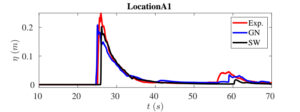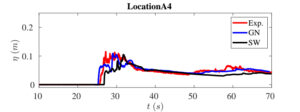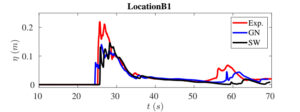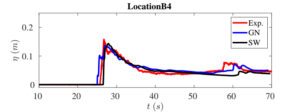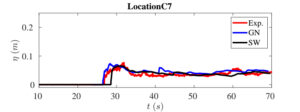 This benchmark is inspired by a measurement campaign realized in a wave tank at the Oregon State University. A complex topography has been realized including a seawall and several buildings, inspired of the real city of Seaside (Oregon) at a 1/50 scale. The experiment consisted in generating a solitary wave with a piston-type wavemaker. This wave (0.2 m, 10 s) has been designed to correspond to the estimated tsunami wave height for the “500 years” CSZ tsunami. The experiment was reproduced 136 times, while displacing the sensors in the urban area (31 locations), and 99 of these trials have been judged as acceptable.
This benchmark is inspired by a measurement campaign realized in a wave tank at the Oregon State University. A complex topography has been realized including a seawall and several buildings, inspired of the real city of Seaside (Oregon) at a 1/50 scale. The experiment consisted in generating a solitary wave with a piston-type wavemaker. This wave (0.2 m, 10 s) has been designed to correspond to the estimated tsunami wave height for the “500 years” CSZ tsunami. The experiment was reproduced 136 times, while displacing the sensors in the urban area (31 locations), and 99 of these trials have been judged as acceptable.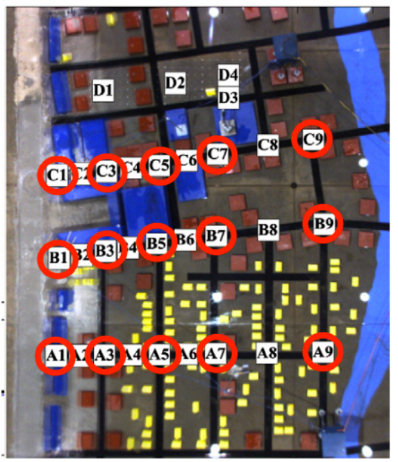
Data concerning flows in urban areas remain very rare, this test-case is particularly interesting as benchmark for models/schemes/codes to simulate the flows in a complex topography. Full details concerning this test can be found in (Park et al. Coast.Eng. 79, 2013). The data available involves a detailed topography, the forcing signal, the positions as well as the time histories of water height in a large number of gauges in the streets of the city model.
We have run simulations with SLOWS on an unstructured triangulation of the spatial domain, and using a hybrid P1 Finite Element / 3rd order Finite Volume scheme. The animations below show the complex wave and flowing dynamics obtained for this realistic case.
The availability of the data allows a quite extensive validation/verification of the residual distribution implementation in SLOWS. This validation is reported below in terms of comparisons between simulations using the shallow water equations (black lines) and the highly non linear weakly dipsersive equations (blues lines) and experimental data (red lines) for the street-gauges highlighted by red circles in the model picture above.
References
M. Kazolea, A.G. Filippini, and M. Ricchiuto, A low dispersion finite volume/element method for nonlinear wave propagation, breaking and runup on unstructured meshes, submitted to Ocean Modelling, https://hal.inria.fr/hal-03402701
